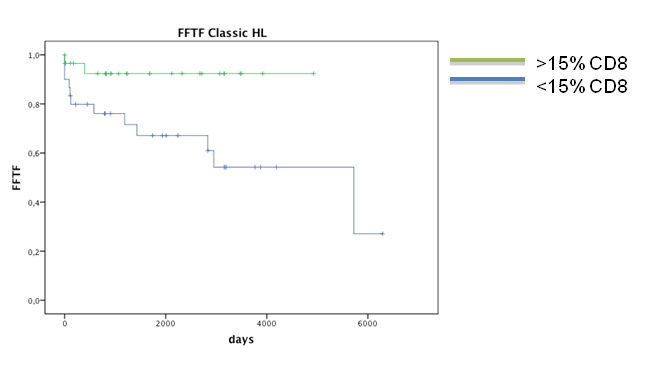hematologia

Contributions
Type: Publication Only
Background
Hodgkin lymphoma (HL) is the most frequent cancer in adolescent and young adults (AYA). It is considered a curable tumor, but still many patients do not favorably respond or quickly relapse after responding to the current chemotherapy. Most widely used prognostic guides still fail to accurately identify those patients with very poor prognosis.
Recently, microenvironment has been a main focus of interest for define risk and disease outcome. Few studies have analyzed the role of CD4+ T-helper cells (THs) and macrophages. Results about cytotoxic T cells remain controversial.
Aims
To analyze the role of the amount of CD8 assessed by flow cytometry in the outcome of patients diagnosed of HL.
Methods
Fresh samples from lymph the node biopsy were obtained during diagnostic process in 80 patients. Single cell suspensions were prepared after homogenizing these samples. Immunophenotyping was made by flow cytometry with standard methods as a tool to help in the diagnosis, which was finally got by standard pathological methods. Clinical data were collected retrospectively from clinical courses and statistical comparisons were performed using SPSS 20.0.
Results
Ratio male/female was 52/46, and median age 37 year (12-85). Forty-six patients (60%) patients had advanced-stage disease (III, IV, B or Bulky disease). Histologic diagnoses were: nodular sclerosis n=58 (73%), mixed cellularity n=10 (12%), lymphocyte rich n=5 (6%), and lymphocyte depletion n=2 (3%), and finally nodular lymphocyte predominance n=5 (6%).The distribution of cases according to IPS prognosis was: good 16%, intermediate 49%, and poor 35%. Considering the total lymphocyte number, CD8+ T cells median value of was 15% (2-75). 76 patients received therapy with ABVD+/-radiotherapy (RT) and 2 with RT alone.
With a median follow up of 5 years, freedom from treatment failure (FFTF) was longer for females (p=0.05), patients achieving complete response to 1st line therapy (p<0.001) and cases with >15% CD8+ cells (p=0.018). This superiority was maintained when only advanced-stage cases were evaluated (p=0,035), as well as in patients with Bulky disease, where all patients with >15% CD8+ remained free from treatment failure (P=0.08).
In multivariate analysis, response to therapy and having >15% CD8+ were the parameters with independent statistically significance.
Summary
An increased number of infiltrating CD8+ cells in the microenvironment of HRS cells assessed by FCM is associated with superior FFTF in classic HL and could be considered as a new biomarker for risk stratification.
Prospective studies must be performed to confirm these results and further understanding of their role in microenvironment.
Keyword(s): CD8 T cells, Flow cytometry, Microenvironment

Session topic: Publication Only
Type: Publication Only
Background
Hodgkin lymphoma (HL) is the most frequent cancer in adolescent and young adults (AYA). It is considered a curable tumor, but still many patients do not favorably respond or quickly relapse after responding to the current chemotherapy. Most widely used prognostic guides still fail to accurately identify those patients with very poor prognosis.
Recently, microenvironment has been a main focus of interest for define risk and disease outcome. Few studies have analyzed the role of CD4+ T-helper cells (THs) and macrophages. Results about cytotoxic T cells remain controversial.
Aims
To analyze the role of the amount of CD8 assessed by flow cytometry in the outcome of patients diagnosed of HL.
Methods
Fresh samples from lymph the node biopsy were obtained during diagnostic process in 80 patients. Single cell suspensions were prepared after homogenizing these samples. Immunophenotyping was made by flow cytometry with standard methods as a tool to help in the diagnosis, which was finally got by standard pathological methods. Clinical data were collected retrospectively from clinical courses and statistical comparisons were performed using SPSS 20.0.
Results
Ratio male/female was 52/46, and median age 37 year (12-85). Forty-six patients (60%) patients had advanced-stage disease (III, IV, B or Bulky disease). Histologic diagnoses were: nodular sclerosis n=58 (73%), mixed cellularity n=10 (12%), lymphocyte rich n=5 (6%), and lymphocyte depletion n=2 (3%), and finally nodular lymphocyte predominance n=5 (6%).The distribution of cases according to IPS prognosis was: good 16%, intermediate 49%, and poor 35%. Considering the total lymphocyte number, CD8+ T cells median value of was 15% (2-75). 76 patients received therapy with ABVD+/-radiotherapy (RT) and 2 with RT alone.
With a median follow up of 5 years, freedom from treatment failure (FFTF) was longer for females (p=0.05), patients achieving complete response to 1st line therapy (p<0.001) and cases with >15% CD8+ cells (p=0.018). This superiority was maintained when only advanced-stage cases were evaluated (p=0,035), as well as in patients with Bulky disease, where all patients with >15% CD8+ remained free from treatment failure (P=0.08).
In multivariate analysis, response to therapy and having >15% CD8+ were the parameters with independent statistically significance.
Summary
An increased number of infiltrating CD8+ cells in the microenvironment of HRS cells assessed by FCM is associated with superior FFTF in classic HL and could be considered as a new biomarker for risk stratification.
Prospective studies must be performed to confirm these results and further understanding of their role in microenvironment.
Keyword(s): CD8 T cells, Flow cytometry, Microenvironment

Session topic: Publication Only


